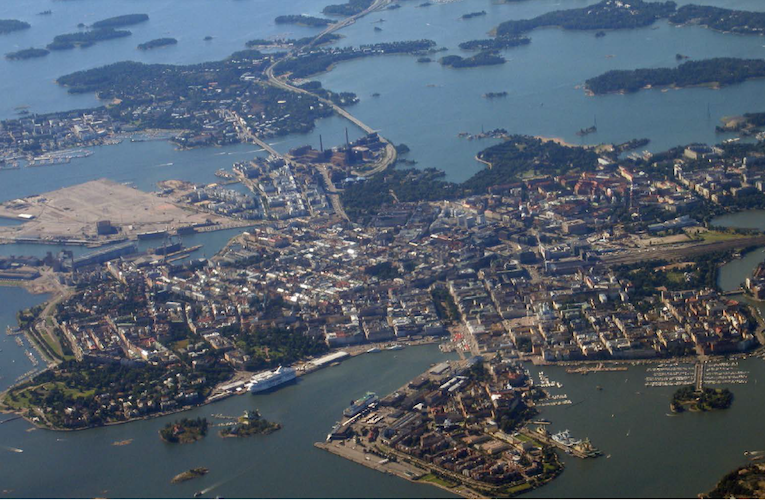
Helsinki is located in southern Finland, on the shore of the Gulf, an arm of the Baltic Sea. It is the largest and most populous city in Finland, with a metropolitan population 1,361,506. Helsinki is spread across bays and peninsulas and over a number of islands with a humid continental climate. A climate risk assessment (Mehrotra et al., 2009) of Helsinki shows that an increase in precipitation and sea level rise as well as increased frequency of extreme events such as floods and heavy winds are the primary climate-induced hazards affecting Helsinki. Helsinki’s low-lying areas are prone to flooding due to increased precipitation and storm surge. The Helsinki Metropolitan Area is leading Finland’s local climate initiatives and demonstrates the adaptive capacity to address certain climate change issues. A compact development plan is to be completed by 2030 which tackles urban sprawl with green infrastructure. The municipalities are responsible for their own coastal protection; with no national plan in place to protect coastal areas. Coastal protection for Helsinki is very important as sea level rise and storm surge are projected to increase in the future. As many coastal areas are being opened for development, housing and infrastructure are being built by the seashore, increasing the vulnerability of this stock to climate risk.
To address the issue of development in coastal zones facing climate risk, the national government needs to implement a National Flooding Management Program along the coastal areas as part of their adaptation strategy in order to protect growing coastal communities and the infrastructure supporting them.
Building a Storm Water Management System as part of the city of Helsinki’s adaptive strategy will improve Helsinki’s future climate change initiatives. By incorporating bioswales and vegetative buffers along the coastal areas, it can help reduce pollution. It can limit the effects of precipitation by reducing impervious covers along the seashore. Helsinki’s population is projected to increase, therefore the incorporation of a Zone Impact Fee Program to prevent urban sprawl is proposed as part of the city’s adaptation and mitigation strategy. Financial incentives will be offered to homes and businesses in certain areas following a re-zoning program informed by climate risk. Risk-free zoned areas—defined by proximity to city center and security from flooding/inundation—will face less of a burden in property taxes and fees under the program to incentivize low risk, high density development.
To enact the strategies outlines above that address climate risk in Helsinki, National, state and local government must develop policy that make these ideas reality. The primary policy mechanism necessary for the tasks at hand will be implementing a nationwide climate change policy to address urban climate risk and fund and coordinate overall city and state government action. This will be achieved through the creation of a national office for rehabilitation and resilient development. This office will manage the strategies outlined above, as well as provide fiscal outlays for these and other projects using revenues derived from the Zone Impact Fee Program and from fiscal transfers to the office from the national government.
This article is a product of Professor Shagun Mehrotra’s Climate Change and Cities class. Views expressed are entirely those of the authors.
References
Astra Project (2007). Flood Preparedness and planning in issues in the city of Espoo. http://www.astra-project.org/02_finland_espoo.html
Ala-Outinen, T. et al. (2004). Ilmostonmuutoksen vaikutukset rakennettuun ymparistoon. Vtt Tiedotteita. http://www.vtt.fi/inf/pdf/tiedotteet/2004/T2227.pdf
Helsinki Horizion 2030. Tailwind http://www.hel.fi/hel2/ksv/julkaisut/kirjat/myotatuulessa_en.pdf
Johansson, M. M., Pellikka, H., Kahma, K. K. & Ruosteenoja, K. (2012). Global sea level rise scenarios adapted to the Finnish coast. Journal of Marine Systems, in press.
Jylhä, K., Ruosteenoja, K., Räisänen, J., Venäläinen, A., Tuomenvirta, H., Ruokolainen, L., Saku, S. & Seitola, T. (2009). Arvioita Suomen muuttuvasta ilmastosta sopeutumistutkimuksia varten. ACCLIM-hankkeen raportti 2009. Ilmatieteen laitos Raportteja 2009:4. 102 s. (english summary) https://helda.helsinki.fi/bitstream/handle/10138/15711/2009nro4.pdf?sequence=1
Mehrotra, S., C.E. Natenzon, A. Omojola, R. Folorunsho, J. Gilbride & C. Rosenzweig. (2009). Framework for city climate risk assessment. Washington, DC: World Bank.
Venäläinen, A., Johansson, M., Kersalo, J., Gregow, H., Jylhä, K., Ruosteenoja, K., Neitiniemi-Upola, L., Tietäväinen, H. & Pimenoff, N. (2010). Ilmastotietoja ja –skenaarioita pääkaupunkiseudun ilmastonmuutokseen sopeutumisohjelmaa varten” http://www.baltcica.org/documents/IlmastotietojaJaSkenaarioita_logo.pdf